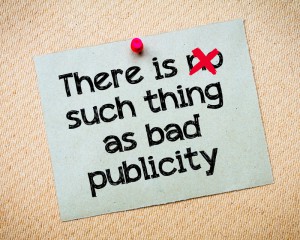 It was a lesson I learned fairly early on in my career in Public Relations and one I will never forget: Good PR sometimes means keeping clear of media coverage. It’s an axiom that not many people understand, but I believe it is actually harder than any other kind of strategic public relations. Let me explain.
It was a lesson I learned fairly early on in my career in Public Relations and one I will never forget: Good PR sometimes means keeping clear of media coverage. It’s an axiom that not many people understand, but I believe it is actually harder than any other kind of strategic public relations. Let me explain.
A deeper understanding
I wanted to be in Public Relations since I was a junior in high school. That is quite the anomaly, as even today, most high school juniors do not have a clue as to what PR really is. But I was challenged by the fact that despite my having an A-type personality, I didn’t know what I wanted to do. It was a fateful visit to the school library where I uncovered this profession called PR. It matched up perfectly with my skillset that was gleaned from my career aptitude test. So did social worker, but the estimated salary for PR was twice as much.
I went on to study Communications at the University of Miami, Florida and then attended the School of Journalism at USC to obtain one of the few MPR degrees in the U.S. at the time: a Masters in Public Relations. Early in my career, I had the good fortune of some phenomenal PR mentors, from my first PR boss Lynn Dorr, who let this PR cub book the highly popular TV show “AM Los Angeles” for clients that included a dog psychologist and the sewing lady, to Jamie James, who clients included a slew of early technology related firms, including a software-only store owned by the co-founder of Ashton-Tate (dBase for you historical data junkies) – and the one and only Liberace.
Now after having spent more than a couple of decades practicing my profession, having represented and worked with some of the biggest brands in the real estate and finance industry, I especially appreciate the nuisances of what we do at WAV Group Communications and I know my colleagues in the industry share the same enjoyment. Another lesson I have learned is that few things are really “new” because in some similar way, it has been done before. That remains true of trying not to garner the attention of the media for very specific occasions. It sounds like the reverse of PR, but in actuality, it is the highest skilled professionals that accomplish this best because it is incredibly strategic.
Myth that any PR is good PR
When I tell people I am in Public Relations (and strategic communications) I still hear an old adage that has never been true, at least not in my experience, about a major component of PR. It’s the quote attributed to none other than Phineas T. Barnum: “There’s no such thing as bad publicity.” Oh, but there is Mr. Barnum, there is. I think PT would only have to read the headline “No more circus elephants” to appreciate how wrong that phrase truly is.
Social media today puts a magnifying glass on everything and instantly connects our globe. That’s a game-changer that makes navigating the world of bad PR especially challenging. The best defense is to always do the right thing, no matter what, and that’s a lesson worth sharing.
A story that never made the news
Many of the stories that illustrate how bad news is never made it in the headlines and the strategy that was employed to make it is something I still can’t share. They are confidential and I have many reporter friends that are going to cringe just at the title of this piece. But my goal here is to share that one principal – that good companies can avoid or minimize bad media coverage by making sure they do the right thing.
There is one story I can share because the bank was merged more than once long ago and just about everyone involved is retired or has passed on. I believe this story would have been headline news Coast to Coast. In fact, I kept seeing the headline in my mind during the time it was happening. I believe it would have made not the CNN news cycle, but all three TV networks. Every major daily newspaper in the U.S. would have covered it because AP certainly would have. The headline that never was written: “ATM Electrocutes Bank Customer.”
An inside look
It all started with a call from the President of our bank operations in Florida. Florida was the bank’s second largest market, and the guy who headed up the operation came to us through an exceptional acquisition of a first class S&L that had grown too rapidly in the Palm Beach area.
He and I became well acquainted, as I had been directed by my SVP to shuttle between our three largest markets at the time: I was running media relations from our California office where I was based, then set up a satellite office in South Florida, where I spent at least a week every month, and then I flew from Miami to Seattle to spend a few days there each month, as we had a huge mortgage machine in the Pacific Northwest.
Since South Florida was my home for a decade when I was growing up, and I was in my late 20s, I enjoyed the travel and the responsibilities. But his call that evening was like no other call I have received in my career. The bank president said on the phone, “It appears that one of our customers was electrocuted at one of our ATMs this evening.”
After my heart sank about six inches in my chest, I began that most important first step: gathering as much information as possible about what happened. We spent about 20 minutes on the phone discussing what happened, what steps he had already taken and what he was going to do next. I quickly created a checklist of action steps so I could brief my boss. Our Florida Bank President had already closed down the ATM in question and locked its doors – the ATM was in a covered air-conditioned booth, common in South Florida. He knew where the hospital the customer had been taken to and we talked through our options.
As the lead spokesperson for our Florida Bank, my number one priority was to make sure this story never made a headline. Because what we learned was that it was not the ATM that caused the electric shock: It was the new lighting system that the contractor had installed, ironically, to make the ATM better lit inside and thus, more safe. The contractor had not properly grounded the lighting system. I knew the bank would be in every news story, as it was a major brand at the time and not the contractor. We also had the deepest pockets and I think everyone at the time believed we would be sued. Everyone, that is, but our Florida Bank President.
Do the right thing
When he and I spoke, he had already said that the bank attorneys advised him to say nothing and to admit nothing. This approach is the opposite of the right PR approach, which was to do the right thing. The President agreed. He told me that what he wanted to do was to immediately go to the hospital and bring flowers to the customer and his family. He wanted to apologize fully and explain exactly what happened. Through all of this, the attorneys cringed at what he suggested, and they certainly didn’t approve of his final request: He wanted to tell the customer that the bank would take care of all of his medical expenses, including rehab, if it was necessary.
But that is exactly what he did. Despite the attorneys warning that the Florida Bank President would be invoking a legal Armageddon by his actions, the lawyers were not giving weight to something crucial to the entire situation: He knew the customer. He had a relationship with that customer. He believed that by doing the right thing, that customer would not go to the media and would not sue the bank.
The story remained out of the media because the President and the bank did the right thing. The customer never sued, and never went public on what happened. And even if the story did get out, I was confident that public opinion would empathize with the bank because of how we handled the situation. We did the right thing.
If we had listened to the attorneys in this case, it would have been national news with a headline that I’d bet if you saw then, you’d remember it today. What I learned is that good PR and doing the right thing go hand in hand. Having a President willing to listen to solid PR advice and not to the attorneys was a risk he was willing to take because he wanted to do the right thing. That is why we stayed out of the media. We did not try to deceive anyone or stonewall anyone or blame anyone else in an attempt to kill the story or direct attention at someone else.
Laying low isn’t always a bad thing
You don’t always have to beat your own drum and you don’t have to always put yourself in the spotlight. Sometimes, laying low and doing good work is the best PR strategy at the right time. A colleague of mine owns a small PR agency and has been representing one of the largest brands in real estate for over three decades. He once confessed that 90% of his job has been to keep this company out of the headlines. I can tell you, to do that, he’s had to work a lot harder than anyone else.




